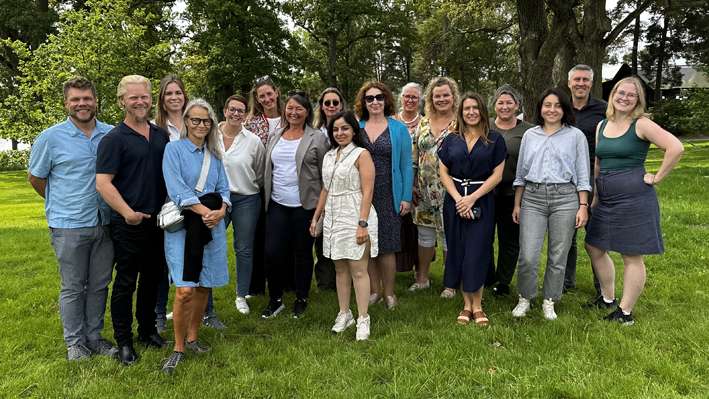Welcome to the Viable Cities family. Here is a brief introduction to what we do and why your contribution is so important to achieving our mission: climate-neutral cities by 2030 - with a good life for all, within the limits of the planet.
Many efforts are underway in Sweden and around the planet to address the climate crisis and transition to a sustainable world. What role do Viable Cities play in this? We assume that the climate transition leads to a higher quality of life for everyone, with greener cities, better air and more space for people. We also assume that the vast majority of technical solutions to achieve this already exist. What we need to do is to change the way we work. Viable Cities works to strengthen the ability to change on a broad front. Since everyone in society contributes to climate change to varying degrees, everyone also needs to be involved in the changes required in society to achieve the goals.
Our work is based on a theory of change that can be summarized in four cornerstones: creating common direction, creating a mandate for change, accelerating learning and portfolio thinking.
We work in the gaps, to get all actors working together and to make all efforts, from the neighborhood to the planet, connect and contribute to a common goal, the mission of climate-neutral cities by 2030 - with a good life for all, within the limits of the planet.
At Viable Cities, we often talk about the mission. We are a mission-driven strategic innovation program since 2018, inspired by economics professor Mariana Mazzucato. What does that mean? As already mentioned, the solutions already exist, now we need to put them together. In short, mission-driven work means joining forces to achieve a clearly articulated, time-limited goal. To make it more concrete, we can refer to the US's efforts to go to the moon. They were determined to do it even though it sounded impossible, and to overcome the challenges along the way, experts and collaborators from many different fields had to work together in new ways. Together, they managed to accomplish the impossible, a lunar mission.
The mission helps to prioritize what needs to be done, and also what can be left undone.
The mission for climate-neutral cities by 2030 is our journey to the moon. Within Viable Cities, 23 Swedish cities and six government agencies are working to get there.
A mission-driven approach is, simply put, a gathering of forces for a specific time-bound goal. So our mission is not "ours", we want everyone on earth to embrace it. Since 2022, the EU has a Climate Neutral and Smart Cities Mission with 112 cities working towards the same mission, as well as missions for clean oceans, healthy soils and finding a cure for cancer.
In 2024, Impact Innovation was launched in Sweden, with five programs that are also mission-driven. The approach is spreading, which is good. We need to join forces to meet societal crises, including climate change. Working mission-driven makes society better equipped to cope with major stresses.
The Viable Cities initiative Climate Neutral Cities 2030 started in 2019 with nine Swedish municipalities. The initiative now includes 23 municipalities, which together account for 40% of Sweden's population. In 2024, many more cities will be involved. These cities - the municipalities and their partners - have taken it upon themselves to test new approaches and solutions, to learn from each other, to make all efforts contribute to the overall goal - the mission.
The Viable Cities team works closely with the process managers and transition teams in each city. Depending on the theme, other competences from the city are involved in the joint mobilization. We call this communication network KOM2030.
Six government agencies - the Swedish Energy Agency, Vinnova, Formas, the Swedish Agency for Economic and Regional Growth, the Swedish Transport Administration and the Swedish Environmental Protection Agency - have taken it upon themselves to jointly support the cities' transition work. Among other things, they have created an innovation team to jointly explore how the authorities can best support the cities' transition.
A key tool for our joint work is Climate City Contract 2030, where cities and government agencies annually sharpen their commitments to achieve the mission. Each city has its own contract, which is signed by the city council Chairman, the directors general of the authorities and Viable Cities. All contracts can be read here. Climate City Contract 2030 is a way to get an overview of the city's overall transition efforts, and a tool to accelerate the transition, as it clarifies where efforts can be strengthened. At the same time, it is a tool to ensure that the work is a long-term process in the city that continues across political mandates. It is also a source of information and inspiration for other cities. The contract has inspired the development of the Climate City Contract within the EU Cities mission.
Other important elements of the work are governanceclimate investment plans, project portfoliosand change management, storytelling and system demonstrators. To explore all this together, we have a range of activities to learn from each other, such as Transition Lab Forum and the Climate Breakfast.
Viable Cities is both an organization and a movement created by all actors working within the framework of the programme or for the mission. The purpose of Viable Cities is to create transformative systemic change based on the mission of Climate Neutral Cities 2030 with a good life for all within the boundaries of the planet. Everyone working towards the mission of climate neutral and sustainable cities by 2030 is part of our family. The mission is global, climate change is happening all over the planet and we want as many people as possible to be part of the transformation journey.
Viable Cities is one of 17 strategic innovation programs, we are a national platform and Sweden's largest investment in the transition to climate-neutral cities. We are financed in a joint effort by the Swedish Energy Agency, Vinnova and Formas. We are evaluated every three years and have a program period until 2030. The Royal Institute of Technology (KTH) hosts the program and our headquarters, Hemmet, is located on KTH's campus in Stockholm on a rooftop with birdhouses, parasols and views of the city .
To get a quick overview of Viable Cities' activities, you can browse through our annual reports, and if you want to read more in-depth about us, you can find our full history on the About Us page.
The program team works for Viable Cities through employment at KTH, Research Institutes of Sweden - RISE, Lund University or Stockholm Environment Institute -SEI, and meets daily in Stockholm, Gothenburg, Umeå, Lund or Kalmar.

The family, the team, consists of about 25 people with different competencies, including researchers, innovation experts, people with experience from municipal, regional and national processes and international cooperation for the transition, and we even have a storyteller. Olga Kordas is the head of the program and also a researcher at KTH, and the team also includes the dogs Alice, Bosse and Lukas.
Our board includes members from cities, companies and universities.
Within Viable Cities, lots of people are involved in different parts of the transition. You can work in a company that is a member of Viable Cities, you can be an economist in a municipality, you can be an administrator in an authority or be employed by an actor in an initiative that we finance.
Whatever your role, your contribution to the joint mobilization is important. As I said, we need to work in new ways to really accelerate the transition. This means that we need to become good at working across the board, in new constellations. A municipality cannot create a climate-neutral, sustainable city on its own. To succeed, everyone in the municipality's geographical area needs to work together: the local business community, citizens, universities and research institutes, civil society and citizens. It also requires cooperation with the region and national government agencies.
We need to challenge the status quo and test new ways of driving development and making decisions. Changing the status quo is not easy, as it requires both courage and perseverance. We also need to accept that we are exploring the road ahead while traveling on it. This is why it is important that everyone involved in Viable Cities agrees on where we are going, and that you know that in your own way, in your own context, you are contributing to the mission of climate neutrality by 2030.

It can be hard to grasp everything sometimes, so we've made a two-minute film that summarizes and explains in a simple way what we do and why it's important. Watch it, and share it with friends and colleagues to tell them about Viable Cities and the work we all do together. There are also more videos on our YouTube channel, where this video is also available in English.
Viable Cities' communication work helps to build a movement among many actors in society to achieve climate-neutral cities by 2030. It is not about "us" communicating to "you", but about all of us working together to explain, clarify and talk about the climate transition. We have put together a communication guide, where you will find materials, short texts and other useful things you can use to talk about the mission, Viable Cities and how you and/or your organization contribute.
Do you need a rollup to showcase our collaboration, or do you want to use our logo or illustrations? Contact kommunikation@viablecities.se and we will help you create the material.
Emotional engagement is key to changing people's behavior, and communication can do a lot here. Viable Cities is developing a methodology to explain how climate-neutral cities can be experienced. The method consists of a number of processes that are based on cities' climate targets and result in a story about what it is like to live climate-neutrally for a day in that city. Kristianstad and Östersund, among others, have tested the method to tell the transition in the city in an engaging way, in video, audio and text. Try it yourself!
No one can do everything, but everyone can do something. By getting involved in different ways, you can help us achieve our mission and, what's great is that you can actually do much more than "just something", you can do a lot. Below you will find some tips, and don't forget to get involved in sustainable development in your neighborhood or city - the more we are the better!
Keep up to date with what's happening by filling in your email and selecting which emails you want to receive news and updates from us.
You can talk about our mobilisation for climate-neutral and sustainable cities with people you know and meet. The Knowledge Hub provides tips on how to do this. In the hub, we have also collected examples of how cities involve citizens, as well as what you as an individual can do.
Share any materials and tips you find with your contacts, both on social media and also directly with people you know and meet. Also, help us spread the examples we have highlighted in the Glo och sno from the 2030 cities - local actions that trigger doing that contribute to the mission, ready to be copied, spread and scaled.